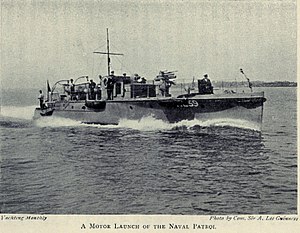|
Motor launch (naval)
A motor launch (ML) is a small military vessel in Royal Navy service. It was designed for harbour defence and submarine chasing. Similar vessels were used by the Royal Air Force for armed high-speed air-sea rescue. Some vessels for water police service are also known as motor launches. Motor launches were slower than motor torpedo boats and motor gun boats World War I serviceAlthough small by naval standards, it was larger than the preceding steam or diesel-engined harbour launches of 56 ft and coastal motor boats of 40 and 55 ft length. The first motor launches entered service in the First World War. These were five hundred and eighty 80-foot-long (24 m) vessels built by the US Elco company for the Admiralty, receiving the numbers ML-1 to ML-580. They served with the Royal Navy between 1916 and the end of the war, defending the British coast from German submarines.[1] Some of the earliest examples, including ML 1, also served in the Persian Gulf from June 1916. After the Armistice of 11 November 1918 a flotilla of 12 Royal Navy motor launches travelled down the Rhine performing duty as the Rhine Patrol Flotilla.[2] The only known surviving example of a World War I era motor launch is ML-286, which now lies in a poor condition on the banks of the River Thames. World War II types
The BPBC Type Two was succeeded by the Type Three 68 ft "Hants and Dorset". Post-war, many motor launches were taken on as pleasure boats. A number of them are on the National Register of Historic Vessels.[3] See also
References
External links
|
||||||||||||||||||||||||||||||||||||||||||||||||||||||||||||||||||||||||||||||||||||||||||||||||||||
Portal di Ensiklopedia Dunia
